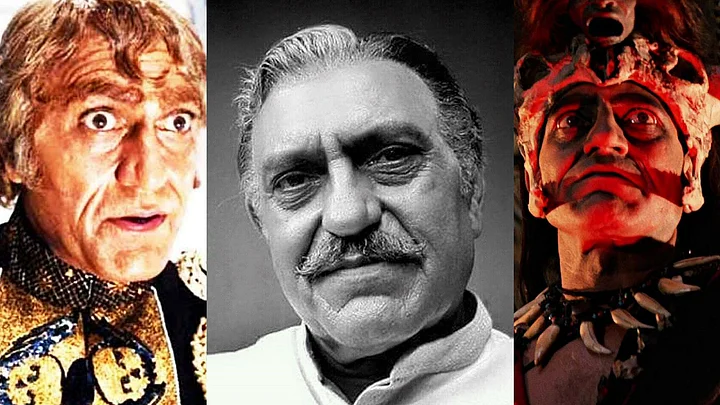What’s the first thing that comes to your mind when you think ‘Amrish Puri’? For the millenials-only-in-definition, I suppose it would always be “Mogambo khush hua”. For the recently-borns, it’s probably “Ja Simran Ja, jee le apni zindagi!”. And for meme lovers, “Aao kabhi haveli pe” is what defines gold.
The iconic dialogues point towards three roles that showcased Amrish Puri’s wide range as an actor. He was never just the villain or just the strict or loving father (a particularly poignant performance as a former freedom fighter diagnosed with cancer, who helplessly watches his son trying to fight corruption in Ghatak (1996), comes to mind).
Amrish Puri managed to infuse his often unidimensional characters with a personality and depth that made them stand out. And this in spite of possessing perhaps the most famous voice in the country after Amitabh Bachchan.
On his birth anniversary (on 22 June), here’s looking back at five of Amrish Puri’s most memorable roles.
Ardh Satya (1983)
Govind Nihalani’s Ardh Satya was Om Puri’s film. But Amrish Puri etched out a memorable role as his father, a retired police constable who’s as orthodox as he is violent, and who thinks nothing of physically abusing his wife. Amrish brought the full force of his personality to the character, and in turn helped add layers to Om Puri’s Anant Welankar.
Indiana Jones and the Temple of Doom (1984)
The very next year, Amrish Puri bagged his next Hollywood biggie (after Richard Attenborough’s Gandhi) as the Indian villain Mola Ram in Steven Spielberg’s Indiana Jones and the Temple of Doom. Charismatic, theatrical and macabre - he pulls out men’s hearts with his bare hands to offer to his deity Kali (more monster than the goddess as far as looks go) - Mola Ram heads a thuggee cult and of course aims to rule the universe by accumulating necessary fantastic powers.
Amrish wrote in his autobiography The Act of Life how he was initially not interested in the role at all, refused to audition and even refused point blank to read out a page in English. He still bagged the role and Spielberg later referred to him fondly as his “best villain”.
Unfortunately, Indiana Jones and the Temple of Doom was not allowed to release in India at that time and Amrish’s role has always drawn a lot of flak for stereotyping racism and stark Orientalism. He in fact got labelled with everyone’s favourite word today: Anti-national.
How did Amrish react? He wrote in the book:
“It was a chance of a lifetime working with Spielberg, and I don’t regret it even for a moment... I don’t think I did anything anti-national; it’s really foolish to take it so seriously and get worked up over it.”Amrish Puri in his autobiography The Act of Life
Hear, hear.
Nagina (1986)
The tantric venture was super successful and brought to Amrish Puri another of his legendary roles. Bhairo Nath takes on the icchadhaari naagin aka Sridevi as they tussle over her husband’s life, an all-powerful mani (a sort of philospher’s stone), and the age-old issue of controlling the universe.
Amrish Puri glares and growls and plays the been, and in short, entertains us to the hilt.
Mr India (1987)
Director Shekhar Kapur describes in his blog how he created Mogambo and his world and how only an actor of Amrish Puri’s calibre could get it right. Because - wait for it - Mogambo actually does nothing! He only threatens and threatens and his plot to take over India inexplicably rests on one solitary house. And he actually doesn’t do anyone any harm!
Writes Kapur: “We had thought of other actors, but it was clear to me (and to others soon) that if there was an actor that could carry off this very very difficult part, it was Amrishji. He was not easy to convince, but then he did not contend with the charm and persuasive power of producer Boney Kapoor.”
And how did he brief the actor?
Rarely does an actor so embrace a part and give it life that I as a director could not have imagined. Amrishji asked me how I wanted him to interpret the part. I was nervous. I could not just say “Mogambo Khush Hua” to an actor of his stature, could I ? After all this was the same man that had done brilliant performances like the ruthless landlord in Shyam Benegal’s Nishant. And many such films. He had an acute understanding and experience of the art of acting. So I said, “Imagine you are playing Shakespeare to 9 year old kids that have no idea who he was. Imagine you have to make it feel mythic and entertaining”. Amrish Ji got it. Never did I have to give him any more instruction, other than stage directions. Each time he brought a new flavour, a new emotion, a different resonance in his voice. He became threatening and lovable at the same time. Each time bringing something out of the ordinary for those lines that have now gone down in history. “Mogambo Khush Hua”.Shekhar Kapur in his blog
The rest, as they say, is history.
Dilwale Dulhania Le Jayenge (1995)
If you think about it, Dilwale Dulhania Le Jayenge is more about the conflict between Baoji and Raj than a love story between Raj and Simran. It’s the story of a rich but spoilt smart aleck trying to win over a hardworking traditional man who has built his life from scratch. And Amrish Puri infuses Baoji with an easy warmth and solidarity which keeps him from becoming an out and out villainous dad. Somewhere, Baoji is a familiar figure - one we would sometimes encounter at home.
(At The Quint, we question everything. Play an active role in shaping our journalism by becoming a member today.)
